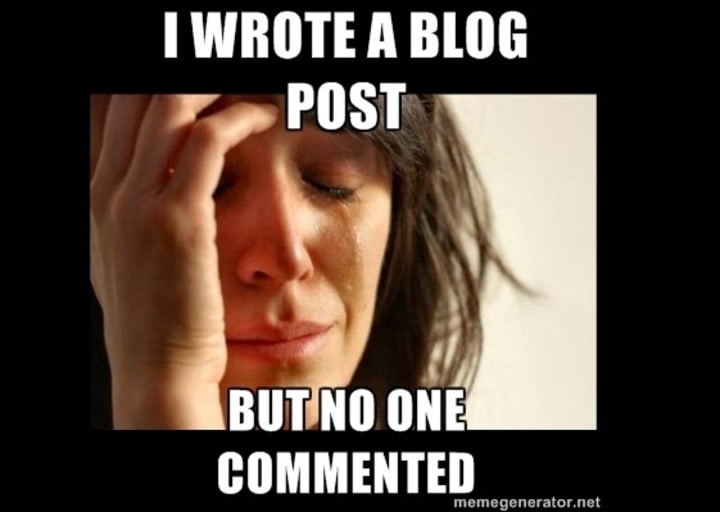How Can I Get More Blog Traffic?
Ten surefire strategies that can help to increase blog traffic.

How can I get more blog traffic is probably the most commonly asked question on the internet.
Most people have already posted the best answers on their own blog regarding their methodology for growing and maintaining traffic; SEO is important, but it doesn’t end there. Quality and quantity of posts are also important factors, and consistency is key, but blogging has turned into a whole production over the past 10 years or so.

It's imperative I point that out because most bloggers have been at the game for years and years. If you ask them how they grew their blog, they’ll certainly tell you that they just kept plugging away, they kept up with emerging technology, and they learned to predict social patterns.
Is there a tried and true 10 step process wherein if you do X, Y, and Z, you will be guaranteed an inflow of traffic? I don't think so, but there are numerous strategies that can help if applied properly and consistently. The important thing is to keep from getting too crazy.
My advice to any novice blogger is to find which blogs do get a ton of traffic and emulate them. It's important to note, though, that lots of people, and I mean lots, lie about their stats, but there are ways to get an idea of whether or not the blog you’re viewing does have a lot of traffic. I will explain how you can do so in just a minute.
First, lots of bloggers visit each other's sites, and they support each other, which is extremely helpful during the infant stages of blogging, but even after years of such a practice, some of these people are getting almost no traffic from their target audience, so if you’ve found your audience, stay on top of current trends, and keep plugging away. If you haven’t found your target audience, you’d better figure it out before you start blogging, or your blog will be all kinds of crazy!

Now, I’ll try to present what has worked for me, and honestly, I am far from the most prominent blogger on the internet, but I believe that my 10 step strategy, which is ever adapting to new trends and new circumstances, can help anyone.
Step 1. Know your target audience.
For whom are you blogging? About what are you blogging? Why are you blogging? What makes your blog different, important, insightful, and entertaining?
In my case, I usually blog about writing; either I try to promote a book or service, or I try to inspire people to write, read, or edit correctly, which is why I always add a link to my site www.storiesbydennis.com.
If you don’t know your audience, you can’t know your topic, and vice versa. Moreover, the topic and audience should complement each other because you need to know how best to present your topic to your audience.
For instance, when I blog about editing, I keep my tone professorial. When I blog about a fantasy book, I use an archaic voice. When I blog about scifi, I get super technical and geeky.
Different audiences, seeking different products and services, respond to different approaches!
Step 2. Visit numerous blogs.
Visit numerous blogs, which are about your topics, and which promote ideas and information or products similar to yours to your intended audience. Your audience is the key to success, so you must do everything to reach them despite the fact that others beat you to the punch.
Look at how the prominent blogs are laid out. Look at how many likes, reblogs, and comments they have. If the bloggers’ stats are relatively low, move on. Try to bookmark all the blogs that you really like, and which also have high stats.

Don’t just look at the layout, which is important, read the blogs and the comments. See how the bloggers interact with their fan base. Look at how many posts they have, and if possible, look at how often they post.
Check to see if they offer anything of value like a product or service. Observe how interactive they are. Is there media of any kind? Pictures? Gifs? Videos? Flash?
Do they have in and outbound links? Do they employ social media widgets and social share buttons, and which ones? If they do have social share buttons, the buttons will usually show how many likes, retweets, and shares have been given!
How is the information provided? Is it just bland facts and procedures, or are there stories and lessons involved? Is there a degree of emotion, empathy, relation?
I personally have found that an attempt to relate to my audience is very helpful in creating fans and return traffic, which is important because if even one person likes my blog, they tell their friends via social media. It does you no good to get a visitor if that visitor simply reads through your perfect information once and never returns, or never sends anyone else to your blog.
You need to create something like a pyramid scheme. You alone can never reach everyone. You must entice your fans to reach other, likeminded people, so that if you get ten fans who share your posts, their friends and families will also share to their friends and families.
Basically, try to emulate blogs with the most comments, likes, shares, and reblogs. It’s possible that a popular blog doesn’t show these numbers, but you know there’s tons of traffic if there are comments from practically every day since the thing was posted.
Step 3. Blog consistently and for a long period of time.
It’s possible to blog once, and with your perfect, maiden post, somehow reach thousands of people, but you can’t count on that. If you do then by your third post with no visitors, you will want to give up, so aim for the long run, and just enjoy blogging.
If you don’t enjoy blogging, you won’t go very far, so make sure to enjoy the process. The more you enjoy it, the more you’ll want to blog, and the more you post, the more visitors you will get. Consider that if you post once a week, you’ll have 52 posts per year, and over 5 years, that’s over 250 posts. Be sure to also add links from one post to another if the topics are correlated, or to other sites so that people can either fact check, or find whatever it is they need or want, like, say, the buy page for a book.
This kind of interaction will get your traffic to stay on your blog, or at least go directly from your blog to what they wish to find. People who want to stay on your blog are more likely to like and share. People who are led from your blog directly to their destination will want to visit again for the next time they are searching for something new.
Just try to think about which blogs you read and why. Then think about which blogs have helped you, and which ones have upset you.
Step 4. Include media.
A picture really is worth a thousand words, but in this day and age, the biggest attraction is the meme. Memes are everything, so add relevant memes to your posts or create them.

Admit it, you smiled!
Gifs and embedded videos are also a great way to provide both information and entertainment.
It really depends on your blog, though. If you are wishing to run a serious blog about the risks of heart disease, a funny meme may not be very helpful, so again, you must know your topic and your audience. Of course, you can create serious and powerful memes for blog posts.
Step 5. Invite people.
I mean to invite people to comment, like, and share. A short, thankful message at the end of a post goes a long way, and someone who has enjoyed your post, but has other things on the mind, might not consider commenting or sharing until they read your thank you message.
Once again, think about how you react to blog posts. Are there times when you find your answer and leave without liking and sharing? Sure. Aren’t there times when you figure: “ah, what the heck, they asked nicely, I will give ‘em a tweet!”
You have nothing to lose by thanking your reader and asking for a like or share.
Step 6. Edit. Let me outline this process.
First, you have an idea for a post. If you jump on your blog, and write, and post, there’s no doubt that your post will be riddled with mistakes (let's hope there are none in this one!), so the first thing you should do is write the post to your writing program; I use Microsoft Word.
Once you’ve written your post, spell check it, and then read through it. “Doe snot” are two, correct words, and spell check won’t likely correct them to “does not”, so be sure to read through your post, and also look for better ways to provide more cogent and insightful information.
After you’re satisfied with your post, figure out where you want to add media and links. Then, you can post to your blog, but preview it before publishing. Nothing turns off a prospective fan more than a blogger who can’t write, or provides incorrect information, or provides jumbled, disorganized information.
Blogging is no longer new or unique, you know? So be sure to blog well.
It’s my opinion that this step is most often overlooked by bloggers who are not quite as successful as they can be. Providing information isn’t as simple as having a friendly conversation; you have to be able to find the best words for the sentence. Then, you have to find the best way to structure the paragraph to provide the idea in the best possible way.
Think about it. When you speak with your friends, how often do they ask for you to clarify something or provide more information so that they can understand? Your target audience can’t just ask you to rewrite your blog when they don’t understand, so be sure that they can understand your blog on their first read through!
It’s unlikely that the first time you write a paragraph you do provide it in the best possible way, so do some editing. Be sure that anyone, even people who may not share your native tongue, can glean the information from your post with ease.
Step 7. Check to make sure your links work.
It has been many times that I think I have everything perfect, but when I preview, or even after posting, I’ll check my links, and for some odd reason, they don’t work properly.
Visitors might visit your awesome blog once, but if your links don’t work, you’ve lost return traffic, which is perhaps more important than initial traffic.
Yes, you want to entice as many new people to visit as possible, but remember that return traffic and fans will share your posts to others, and that’s how you generate a huge influx of new visitors; it’s from other visitors.
Step 8. Promote.
It does you no good to post an article, and then tell no one that it exists. It does you no good to post an article, and tell no one to like and share.
Some people love promoting. Some people hate promoting. If you’re all promotion and no content, you won’t get very far. If you’re all content and no promotion, you won’t get very far, so try to blog once a week, and promote once or twice a week.
There are numerous plugins that will promote your posts to your social media outlets automatically.
Spend some time on social media socializing as well. It’s called social media, not automated post media, and your fans want to be able to connect with you, YOU, not just your blogs and posts. Be a real person when you promote.
Fans are more likely to follow you on social media nowadays than sign up for your email updates. Why? On social media, they can talk to you and to likeminded people about similar topics, ideas, products, and services. They can’t do that through an email subscription.
Step 9. Reuse content.
This is kind of like retweeting your own old tweets.
Let’s assume you have blogged for a year. You now have 52 posts. Don’t just promote your newest post; promote your old posts, too. Add new links between your old posts and new posts, especially if something you wrote last year has become important again.
On the flip side, delete old blog posts that are either no longer pertinent, or contain ideas that have been presented again in a better way through your newest posts.
Recycling content is another one of the overlooked steps. A lot of people get so caught up in releasing new content, which is important, but they forget the relevance of their old posts. People are probably still looking for that older information, so give it a few tweets, or re-post it on FaceBook.
Don’t forget that as you progress along the art of blogging, you will get new fans on social media, and they probably won’t go through all of your posts, so if you want to them to continue engaging, as well as sharing your posts with their contacts, recycle your old content; it’s almost like a free post, which means you could even take a break for a week or two!
Step 10. Guest post.
Even I’m guilty of neglecting this step.
It can be tough to post something to someone else’s blog when you want the traffic on your blog, but adding a link back to your site is very helpful. On the other hand, it can be frustrating to invite others to post their ideas to your site, but those people will add a link from their site to your blog (hopefully), which will entice their fans and readers to visit your blog.
This is kind of like what was mentioned at the beginning of this article. New bloggers will often visit one another’s site, and they’ll post on each other’s sites in the hopes of pooling their fans. It doesn’t really work because usually the bloggers are so dissimilar, and neither have any fans, so the cross promotional idea gets lost in interpretation.
Guest posting can be extremely effective, though, if both you and your guest, or host, are similar in tone. For example, two tech geeks can blog about GUIs on each other’s blogs and do well, especially if both tech geeks already have a ton of fans.
In the end, as I said, there is no tried and true methodology, but experimenting with the steps above has helped me out quite a bit.
I also recommend watching some SEO videos on YouTube as well as some social media optimization videos.
Not everything will work for every blog, so you’ll have to spend time experimenting, but there is little doubt that a combination of the factors I have provided will help to increase traffic to your blog. The important things to remember are; have fun, be consistent, and set a long term goal. Good luck!
If you liked this post, be sure to tell your friends. Thanks for reading!
About the Creator
Aaron Dennis
Creator of the Lokians SciFi series, The Adventures of Larson and Garrett, The Dragon of Time series, and more.






Comments
There are no comments for this story
Be the first to respond and start the conversation.